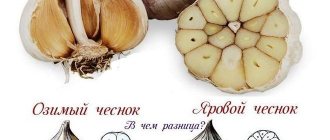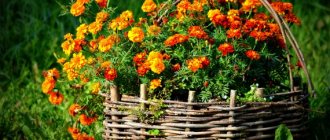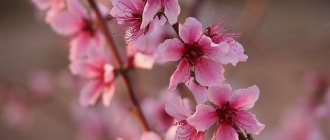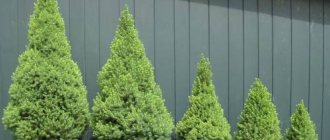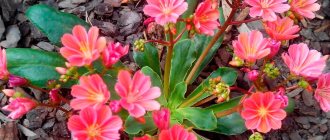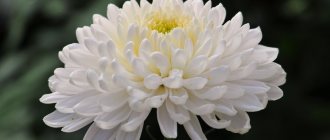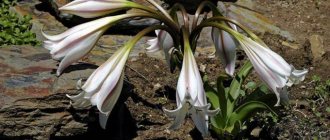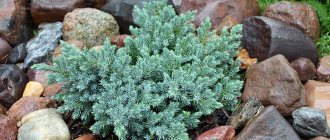Description of the coniferous plant
An interesting dwarf Christmas tree was discovered in Canada at the beginning of the last century. After a series of studies, scientists came to the conclusion that this tree appeared because Picea glauca (Canadian gray spruce) mutated. In appearance, the Canadian spruce conica looks like this:
- the crown is cone-shaped, very dense and fluffy;
- needles up to 1 cm in length of a light green shade densely cover the branches;
- in the lower (widest) tier the crown diameter averages 80 cm;
- The roots are not long, located close to the surface.
The growth of conika is very slow, young “individuals” add about 6-8 cm per year. At the age of 10-12 years, the height of the seedling is approximately 1 meter. After this peak, the growth rate noticeably decreases, and each year the height increases by only 2-3 cm. A Christmas tree can live for about 300-500 years.
Common varieties
Konika spruce has many varieties . But the most common varieties include: Alberta Globe, Maigold, Elegance Compacta, December, Gnome. Each of them has one or more qualities that distinguish it from other representatives of the Canadian Christmas tree.
Albert Globe
This variety differs from others in its very soft, dense and decorative needles, which on young specimens have a yellow-green color, and on adults - rich green . Alberta Globe grows up to 1 m in height and width, acquiring a spherical shape. It grows very slowly. It has a shallow root system, so the soil should not be allowed to dry out. Loves sunny areas and partial shade. Can be used to create compositions in the garden or as a potted plant.
Maigold
Dwarf coniferous tree with a dense, regular, conical crown . Reaches a maximum height of 1.5-2 m. Annual growth is 6–10 cm in height and 3–5 cm in width. The needles are short (only 10 mm), radial, sparsely spaced, yellow-green in color. Young trees are painted in a golden hue. The branches are thin, numerous, rigid, and short.
Find out more about the description of prickly spruce of the Maigold variety.
Elegance Compacta
This variety of Canadian spruce is much stronger and more resilient than Konica. Grows up to 2.5 m tall, has a bright green crown . Young shoots are colored light green. Cones up to 8 cm are formed on the tree.
December
The December variety has a denser, cone-shaped crown. The trees reach a height of up to 3-4 m and a width of up to 2 m. Rapid growth is noted, about 8–15 cm per year . The needles are radial, soft, non-thorny, light green, 10 mm long. Most often, a representative of the variety is used in single plantings. It withstands low temperatures well and grows in sunny areas with loose soil.
Dwarf
The Canadian spruce variety Gnome was developed in Czechoslovakia in 1960. It is a miniature tree, with a maximum height of up to 1.5 m . The crown is dense, conical, fluffy, gray-green in color. The annual growth is up to 2.5 cm. It is a frost-resistant variety and can withstand drought well.
Did you know? Vitamin feed for livestock is prepared from spruce needles.
Buying a seedling in a pot
Modern trends dictate the fashion for preserving natural green spaces, so you can decorate your room for the New Year by buying a konica spruce in a pot. In order not to spoil the holiday, you should adhere to some rules.
- When installing a conic as a New Year's tree, you should find a place that will be removed from all active heat sources.
- The tree only occasionally needs to be turned towards the light.
- If the room where the Canadian guest is standing is heated, it is necessary to spray the crown from time to time.
- Wood requires increased air humidity, so it is better to place a bowl of water near it.
- At the end of the holidays, be sure to put the spruce on the balcony or loggia, since in winter this plant requires a temperature of no more than +10 degrees, and this is extremely difficult to achieve at home. Cover the top of the crown with burlap to create an optimal humidity regime for the tree. Wrap the pot with insulation to prevent the soil from freezing.
- Dwarf Canadian blue spruce conika can grow at home for the first 3-4 years so that it can finally get stronger. After this, the tree is ready to be transplanted into the open ground of the site.
Spruce Konika - planting
Similar work is carried out in the spring so that by the cold weather the seedling has time to take root and overwinter. Canadian spruce Konica Maigold is planted as follows:
- The day before planting, water the soil in the pot so as not to damage the roots when overloading.
- The planting hole should be twice the diameter of the container in which the spruce was purchased.
- Drainage made of crushed stone or crushed brick is poured into the prepared hole. Layer thickness is about 15 cm.
- The seedling must be positioned so that the junction of the trunk and root remains at ground level.
- The remaining voids are filled with soil mixture and compacted.
- Water and mulch the soil around the trunk.
Planting a seedling on the site
Glauca conica spruce, like all representatives of its genus, cannot tolerate drying out of the roots, so when purchasing, pay attention to seedlings that are sold in a container with moistened soil. Planting koniki spruce is the most crucial moment on which the further growth and development of the tree depends. When planting, you should adhere to the following rules:
- Planting conics in the garden should be done on a cloudy day at the end of spring.
- Choose a sunny place without drafts. In the shade, the correct shape of the crown may become distorted, and the tree will become less attractive.
- The hole for planting must be prepared in advance. The bottom should be covered with a layer of broken brick or crushed stone.
- The soil mixture should also be prepared in advance. For this purpose, a mixture of sand, garden soil, humus and peat in proportions of 1/2/1/1 is suitable. It will not be superfluous to add some mineral fertilizers, for example: Zircon, Epin.
The landing process looks like this:
- Soil is poured into the hole on top of the drainage in such an amount that the soil from the container can then fit. Waters well.
- The plant is carefully removed from the container and immersed in the prepared hole.
- The trunk is well aligned on all sides.
- The free space is filled with the prepared soil mixture.
- The filled hole is well watered; this will require about 10 liters of water.
- Finally, a small hole is created near the trunk for further watering, and the trunk itself is covered with a 5-centimeter layer of mulch (pebbles, gravel and other covering materials).
- It is better to cover the tree at first so that the unaccustomed needles do not get burned in the sun.
El Konika - place to plant
To choose the right location, you need to consider the following factors:
- Konika spruce takes root well in partial shade, and in the sun, but without UV rays, it will grow more slowly. In the shade, the cone-shaped shape of the tree may change, and the plant will lose its decorative properties. The lack of sunlight can cause changes in the color of the needles, which will negatively affect its decorative effect.
- Due to the characteristics of the root system of the miniature spruce, it must be planted in a windless area. The root system of this plant has one peculiarity: over time, the root dies, and the tree is supported only by superficial roots, which can be easily damaged.
- The soil for Konica spruce should be moist (80-90%), the ideal option is loamy, sandy loam soil with excellent air and water permeability. In order for the tree to take root well and decorate the landscape of the site, before planting it, it is important to choose and prepare the place correctly in advance.
Caring for decorative spruce
If you are wondering how to care for konica spruce, then care can be characterized as minimal. House conika does not require pruning, replanting or additional crown maintenance. Despite its unpretentiousness, a little proper care will additionally ensure the preservation of the beauty of the conica Christmas tree.
- In not very hot and dry summers, moisture is provided by natural precipitation.
- On hot days, water the plant regularly (as the top layer dries), while spraying the crown.
- The first two months require weekly watering. If a crust forms on top of the soil, be sure to loosen the top layer.
Attention! The tree's roots are located close to the surface of the earth. Therefore, the plant cannot easily tolerate soil compaction or trampling of the earth in an area with a diameter of 1 m around the crown.
- Sonica is resistant to frost, but, nevertheless, the first couple of years should be thoroughly mulched for the winter in the area near the trunk.
Important! Even though the tree can be grown in open ground, in the spring it can receive significant sunburn. Burns manifest themselves as browning of needles. Professional gardeners recommend wrapping the crown with material in the spring so that it diffuses the sun's rays and does not interfere with the passage of air.
Spruce Konika - reproduction
There are two ways to increase the number of trees:
- Use of seeds
. In this case, it is a long and labor-intensive process: the seeds need 4 months. keep in the refrigerator at +4°C. For a better effect, sprinkle the top layer with snow. Then they are dipped into growth stimulants for a day and immersed in prepared soil. Cover with film and place in a warm and dark place until germination. After the greenery appears, move it to a bright place, water it and open the film to prevent mold. - Propagation by cuttings
of Konica spruce is carried out as follows. The material is cut in early spring (late February-early March), they can take root in just three months. They need to be cut from the bottom of the spruce with a small piece of the mother branch. After this, the cut area is treated with a root formation stimulator and placed two centimeters into the prepared soil. To maintain the required level of humidity, the seedling needs regular watering and spraying.
Where is the best place to plant a Christmas tree?
Decorative spruce konika in open ground looks most advantageous in the most prominent areas:
- near the gazebo;
- at the entrance to the house;
- At the playground.
The dwarf guest looks great, both in single compositions and in group plantings in combination with coniferous trees of other species. The trees are especially interesting in the off-season, when at the foot there is a green lawn, creeping tenacious plants or contrasting antennae.
The plant looks beautiful when new shoots appear, as the tree turns into a bright green cone of fabulous beauty. In Russian latitudes, this period falls in May.
The most common diseases of Canadian spruce
Decorative conika spruce can be affected by various infections, and only timely detection of sores and their immediate treatment can save it.
- Rust—orange growths begin to appear on the branches, and the needles quickly turn yellow and fall off. The photo shows how badly the tree can suffer. Treatment of the crown with special preparations such as “Vectra” and “Glyokladin” for a month, once a week, is suitable as a treatment.
- Schutte's disease is caused by a fungus. The needles darken, then become covered with a whitish coating and fall off. Initially, you can save the tree by spraying it with a solution of copper sulfate, then treating it with Trichodermin and Alirin-B, and in advanced situations all that remains is to dig up and burn the seedling.
Spruce Konika - diseases and pests
If the conditions for caring for the plant are violated, the spruce may get sick or become the target of a pest invasion. Neglect of the rules can lead to the following diseases of the Koniki spruce:
- Rust
. This is a fungal disease that appears as orange spots on the branches. This can be cured by using special preparations for spraying the crown and trunk, for example, Topaz. - Shute
. This is an illness that can be caused by a fungus. At the first stage, the needles darken, at the second a white coating forms, and at the third they crumble. By identifying the disease at the initial stage, the plant can be saved; in advanced cases, it is better to dig it up. Treatment is carried out with a 1% solution of copper sulfate.
Even perfect care will not save Konica spruce from pests. On spruce you can find green aphids, shoot moths, spider mites or sawflies. To effectively combat insects, the following drugs are used: “Aktara”, “Fitoverm” or “Confidor”. For prevention, one spring treatment is enough, and if detected, several will need to be carried out to completely get rid of pests.
Reviews about growing Christmas trees
Reviews about the features of growing dwarf spruce are mostly positive.
- Elena: I studied the description and features of caring for wood and decided to try it. As soon as the New Year passed, we immediately took the Christmas tree out onto the balcony, since at home the conica began to wither and get sick. On the balcony she quickly came to life. Now we protect only from severe frosts.
- Evgeniya: I have long wanted an exotic indoor flower. They gave me a konica. I thought it was possible to raise her in a room on a permanent basis, but it didn’t work out. In winter, the plant needs low temperatures, and I don’t have a balcony. I couldn’t save it; it disappeared from the room.
- Irina: In the spring, conica got sunburn because I planted a fragile plant in the ground early. I barely saved it; I had to remove the damaged branches. Now the sores have healed, hints of new needles have appeared.
The dwarf growth of the mutated Christmas tree turned out to be a special advantage for the Canadian guest. Such an ornamental plant will decorate every area, and its ease of care will make it accessible to everyone to grow. If you have any tips or tricks for beginners, be sure to share them in the comments.
